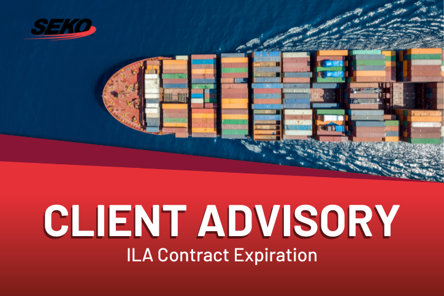WHAT’S THE LATEST
The International Longshoremen’s Association (ILA) and the United States Maritime Alliance (USMX) will resume master contract negotiations on 1/7. The current contract extension is due to expire on 1/15, with no agreement reached yet.
In December, President-elect Donald Trump announced his support for the ILA’s position on automation, which remains the most significant topic under discussion at the bargaining table. The ILA has taken a firm stance against further implementation of automated systems, particularly semi-automated rail mounted gantry cranes (RMGs), while port operators maintain that modernization is essential for maintaining competitiveness and efficiency.
The ILA is prepared to strike again if an agreement is not reached by 1/15. It is estimated that for each day the ports are closed, it will take around a week of recovery.
KEY IMPACTS ON GLOBAL TRADE
The potential strike could disrupt operations at ports critical to global supply chains, affecting the movement of goods and escalating costs for importers and exporters. Main carriers have announced disruption surcharges to offset potential labor-related costs:
- CMA CGM: Peak Season Surcharge of $1,500 per unit from 1/15
- Yang Ming: Port Congestion Surcharge of $800/TEU and $1,000/FEU from 1/15
- Hapag-Lloyd: A Work Disruption Surcharge (WDS) of $850 per 20-foot, and Work Interruption Destination Surcharge (WID) and $1,700 per 40-foot box, effective 1/20
- More carriers are expected to announce similar measures
Cargo bookings for U.S. East and Gulf Coast exports may face delays or cancellations, with some carriers halting bookings for hazardous and refrigerated goods as early as 1/8.
U.S. importers are being urged to clear cargo before 1/15 to avoid demurrage, detention or additional fees linked to port congestion and delays.
RECOVERY TIMELINE PROJECTIONS
Initial Impact Phase (Days 1-7 of Disruption):
- Terminal congestion reaching 85-90% of capacity
- Vessel queuing beginning at anchorage points
- Interior point intermodal (IPI) cargo facing 3-5 day delays
- Local delivery windows extending to 48-72 hours
- Empty container returns restricted at terminals
Early Recovery Phase (Weeks 1-2 Post-Resolution):
- Terminal congestion decreasing by 15-20% weekly
- Vessel schedules requiring 10-14 days for normalization
- Chassis availability remaining tight with 2-3 day wait times
- Container dwell times 2-3x normal levels
- Limited appointment availability for cargo pickup
Full Recovery Phase (Weeks 3-6 Post-Resolution):
- Terminal operations returning to 85-90% efficiency
- Vessel schedules realigning to normal rotations
- Chassis pools rebalancing across networks
- Container dwell times approaching standard levels
- Regular receiving and delivery patterns resuming
UNDERSTANDING RECOVERY DYNAMICS
The path to operational recovery will vary significantly across different ports and regions, influenced by several key factors that shippers must carefully consider in their planning.
Scale & Infrastructure Impact
Major gateway ports such as New York/New Jersey and Savannah face unique challenges due to their operational complexity and cargo volumes. SEKO experts predict that these larger ports will typically require an additional one to two weeks for full recovery compared to smaller ports. This extended timeline stems from their intricate networks of terminals, carriers, and inland connections.
Ports with significant rail dependencies are particularly vulnerable to prolonged recovery periods, as the ripple effects of port closures cascade through the inland transportation network.
Volume & Capacity Considerations
The magnitude of disruption compounds daily, creating substantial operational challenges. For each day of closure, major ports accumulate backlogs of approximately 25,000 to 30,000 TEUs. This volume translates into a recovery period of 7-8 days for each day of shutdown. During the initial weeks of recovery, terminal productivity typically operates at 15-20% below normal capacity as operators work through the backlog while managing newly arriving vessels.
Seasonal & Market Factors
The timing of port disruptions relative to seasonal trade patterns significantly impacts recovery trajectories. The approaching Chinese New Year traditionally brings increased cargo volumes, which could extend recovery timelines by one to two weeks beyond baseline estimates. Weather-related disruptions, particularly common during winter months, may add 3-5 additional days to recovery times.
WHAT’S NEXT?
As your logistics partner, we are ready and able to pivot quickly. Our team is monitoring the situation closely, hoping an agreement will be made before the expiration of the current contract. In the event of labor disruptions, we’re prepared to implement contingency plans to ensure continuity of our export and import services where an alternative routing is possible.
For critical cargo that must be shipped, clients should consider routing through the U.S. West Coast or temporarily moving via airfreight.
We will frequently communicate and advise on the situation as more details become available. If you have any questions, please reach out to your SEKO representative, or email us at hello@sekologistics.com.





